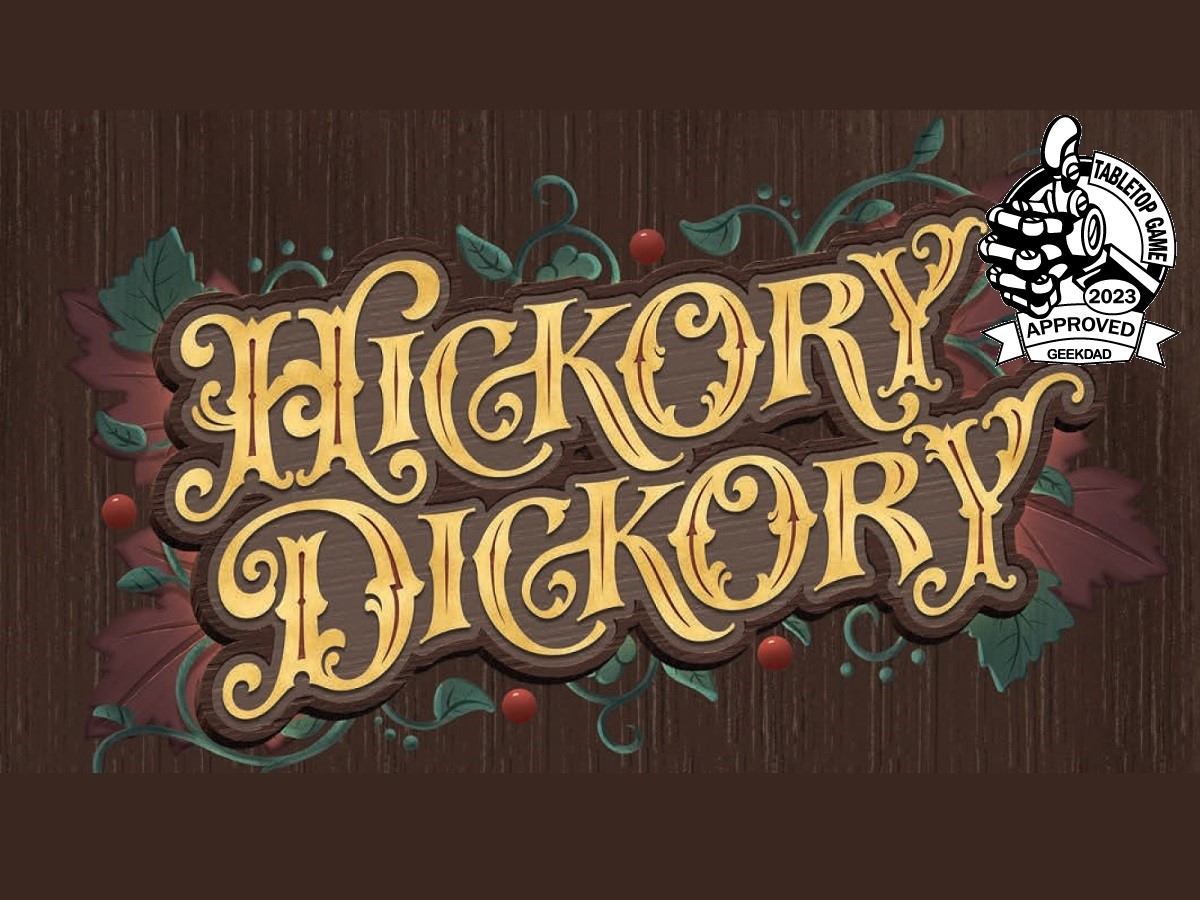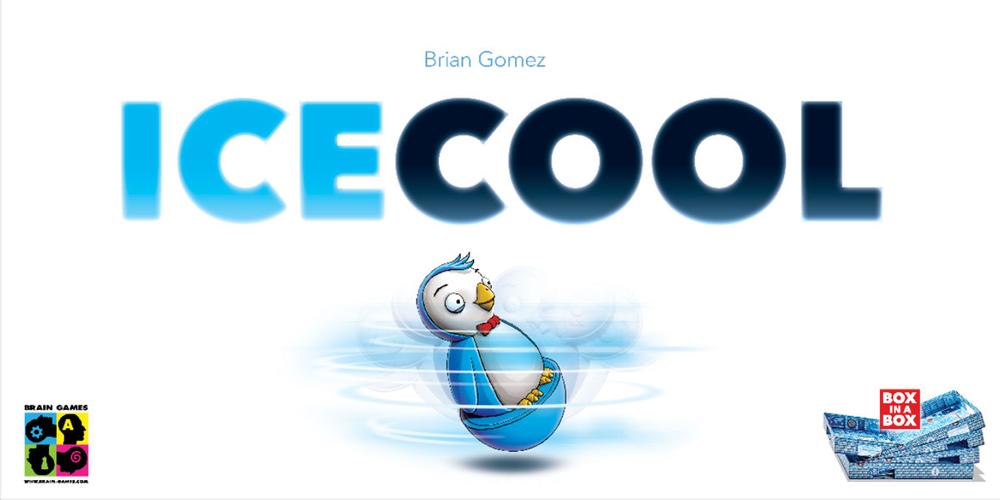Lord Cuckoo who reigns at the top of Tockton Clock has declared a Royal Scavenger Hunt. All mice have been invited to participate and bring items to the bird in exchange for berries. The fun only lasts until the clock strikes 12. Can your mice get the most items and also find Lord Cuckoo’s royal relics in the new tabletop game Hickory Dickory?
What Is Hickory Dickory?
Hickory Dickory is a worker rotation scavenger hut game for 2- 4 players, ages 10 and up, and takes about 60-120 minutes to play. It’s currently available at your FLGS or on Amazon for $60 for a copy of the game. Hickory Dickory was designed by Sawyer West and published by Plaid Hat Games, with illustrations by Sonja Müller.
Hickory Dickory Components
Here is what you get in the box:
- 1 Clock Board
- 1 Clock Hand Assembly
- 2 Minute Hand Blockers
- 1 Chain Track Board
- 1 Pinecone Weight Token
- 2 Side Boards
- 4 Hunt Boards
- 1 Bag
- 93 Item & Relic Tiles
- 12 Action Space Tokens
- 16 Mouse Cards
- 20 Mouse Meeples
- 1 Priority Track Marker
- 4 Score Markers
- 12 Quest Cards
- 13 Favor Cards
- 1 Cat Die
- 2 Cat Paws
- 8 Point Tokens
- 2 Priority Track Blockers
- 2 Reference Tiles

The clock board consists of the main board along with the two side boards, the chain board, and the clock hand assembly. These are all put together when setting up the game.
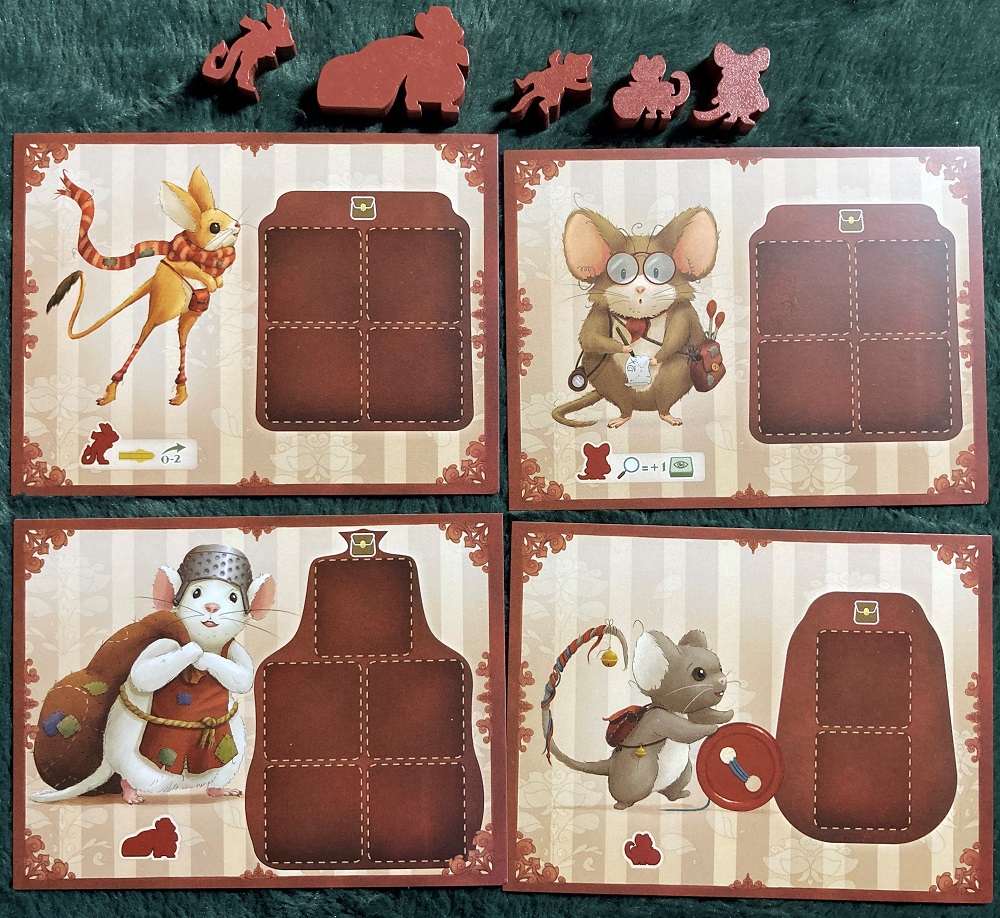
Each player has four mouse cards and five mice meeples in their player color. Each mouse has a different ability. The Scaler mouse runs up the chain at the bottom of the clock to score points. It does not have a mouse card. The Scavenger mouse takes up two spaces on the minute hand, but also has a fifth space in its back for carrying items. The Scurrier mouse, when it jumps off the minute hand or is bumped off, can jump either onto the outer ring space as normal or one of the two next outer ring spaced clockwise. When the Spotter mouse gets to draw a tile from the bag, it can draw and extra tile and then select one to keep before returning the other to the bag. Finally, the Scamp is gained with an action at the 1 space. It acts like one of the other non-Scaler mice, but only has space for 2 items in its bag.
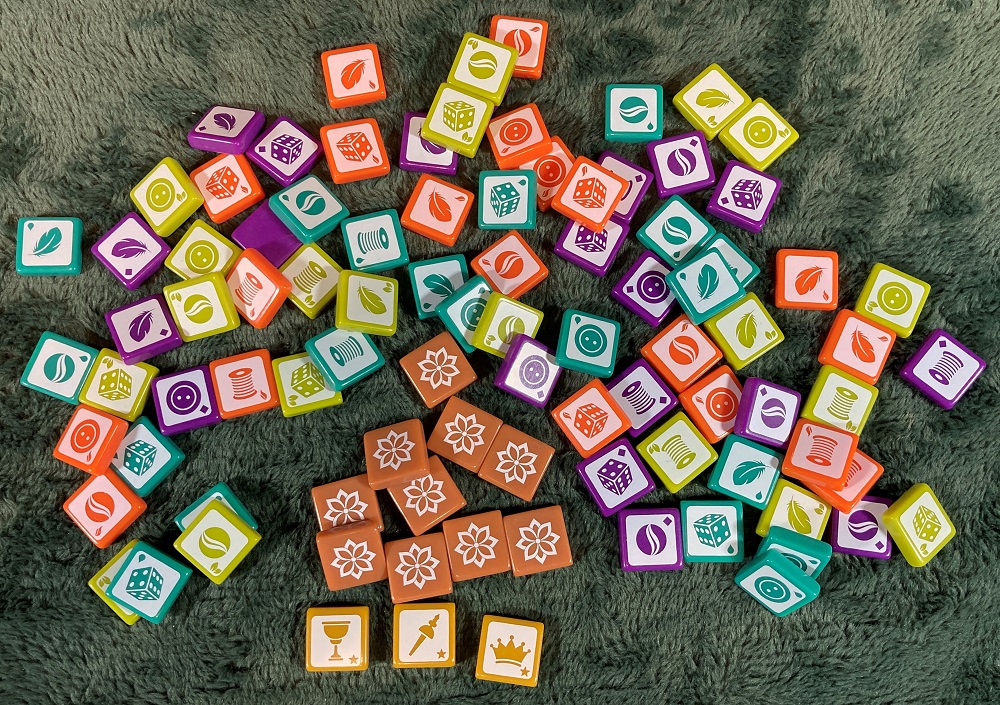
Hickory Dickory comes with colorful plastic tiles that represent various items as well as relics lost by Lord Cuckoo. Your mice collect these items and relics and use them to score points needed to win the game. The tiles are drawn from a cloth bag which also stores them between games.
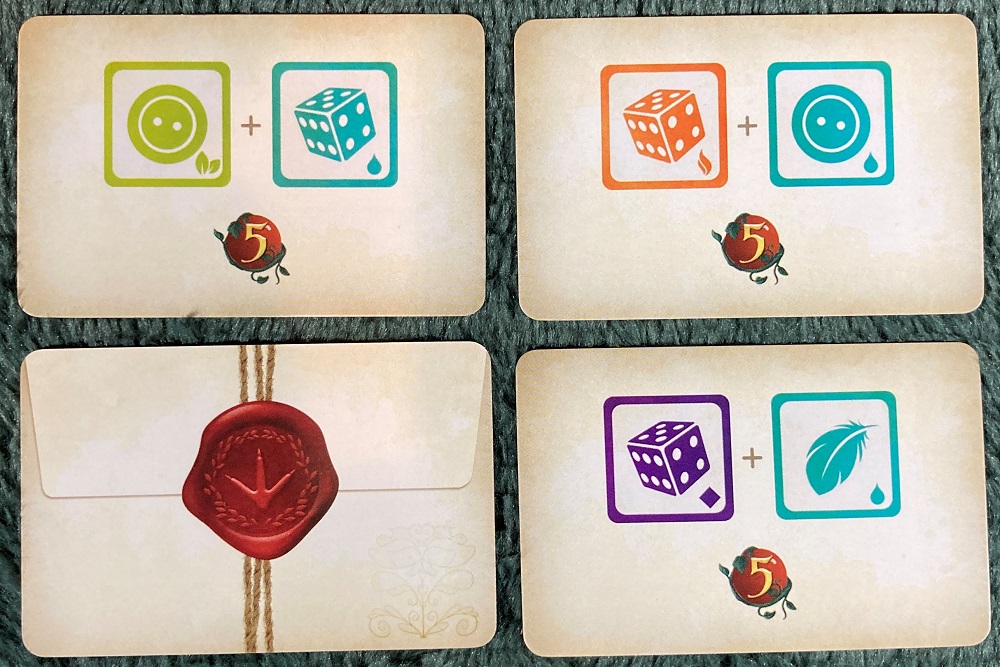
Quest cards show items on them. When delivering items, if a mouse has the items listed on a quest card in their delivery, that player scores the additional points listed on the quest card. Only one quest card can be used per delivery.
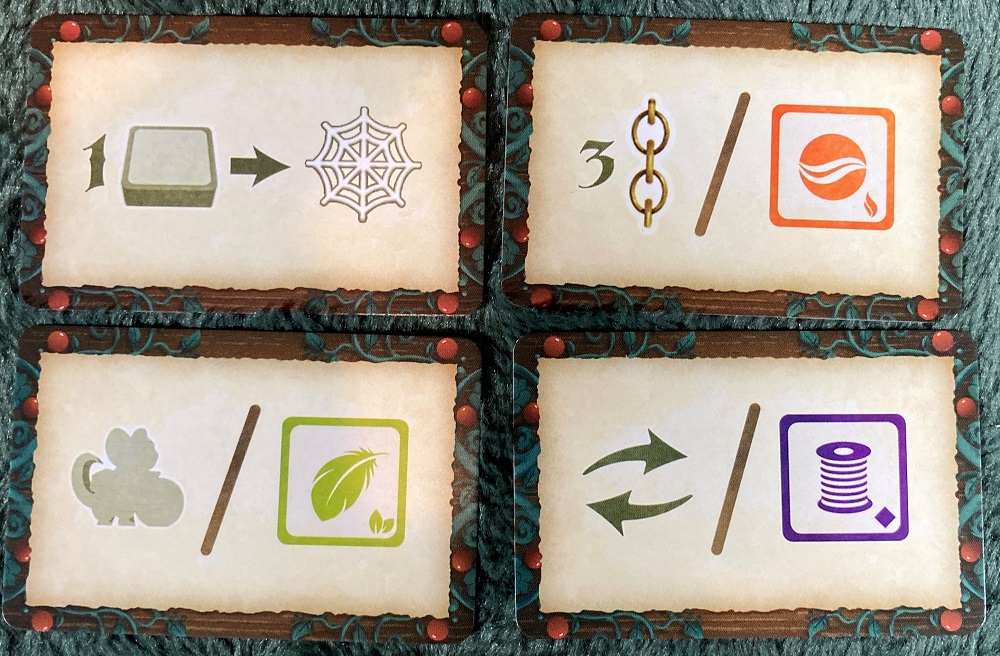
Favor cards can have an action icon on them. Some also have a bonus item icon as well. The actions can be played during an activation of one of a player’s mice. This does not replace the action at their space, so you can perform an additional action. A player can only have a maximum of two favor cards at one time. The bonus item on a favor card can be used when a mouse delivers. However, if the item is used for a delivery, the action on the card cannot be used as well. Each player starts with one favor card.
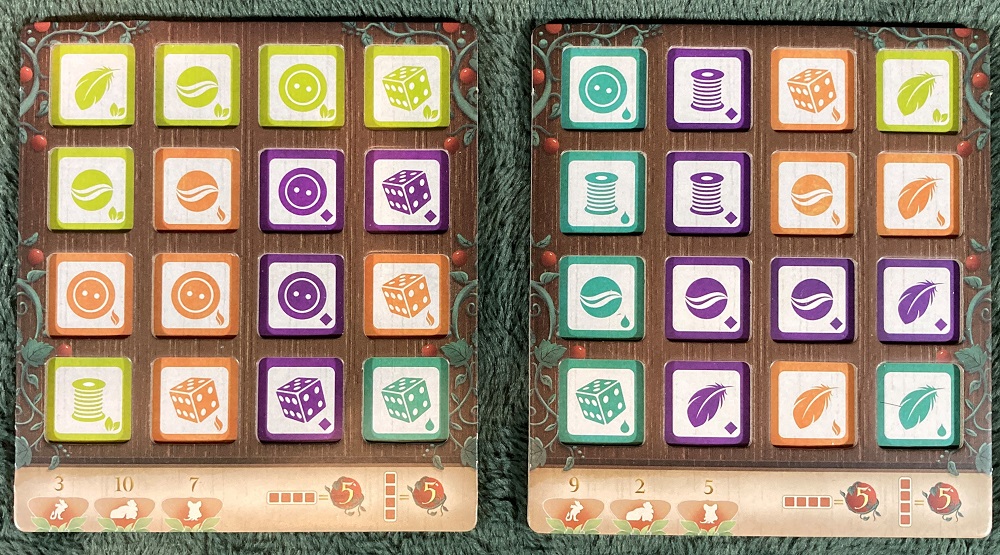
Each player gets one of the four hunt boards. After making deliveries, players place matching tiles on their hunt boards in order to earn more points at the end of the game. Each completed row or column scores 5 points. The hunt boards also show the starting location for that player’s mice.
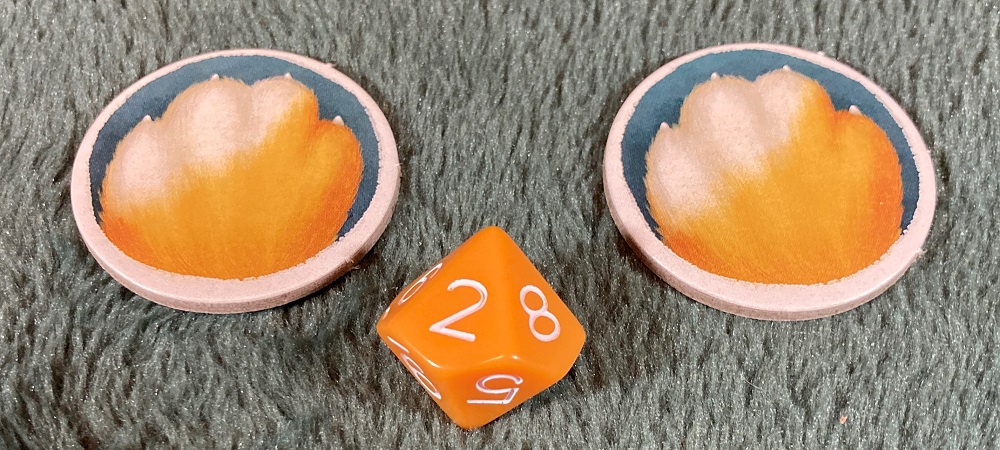
Starting with the second round of a game, players roll the cat die and place the two cat paw tokens on the corresponding spaces. The cat paws essentially block spaces around the clock and prevent mice from activating at those spaces.
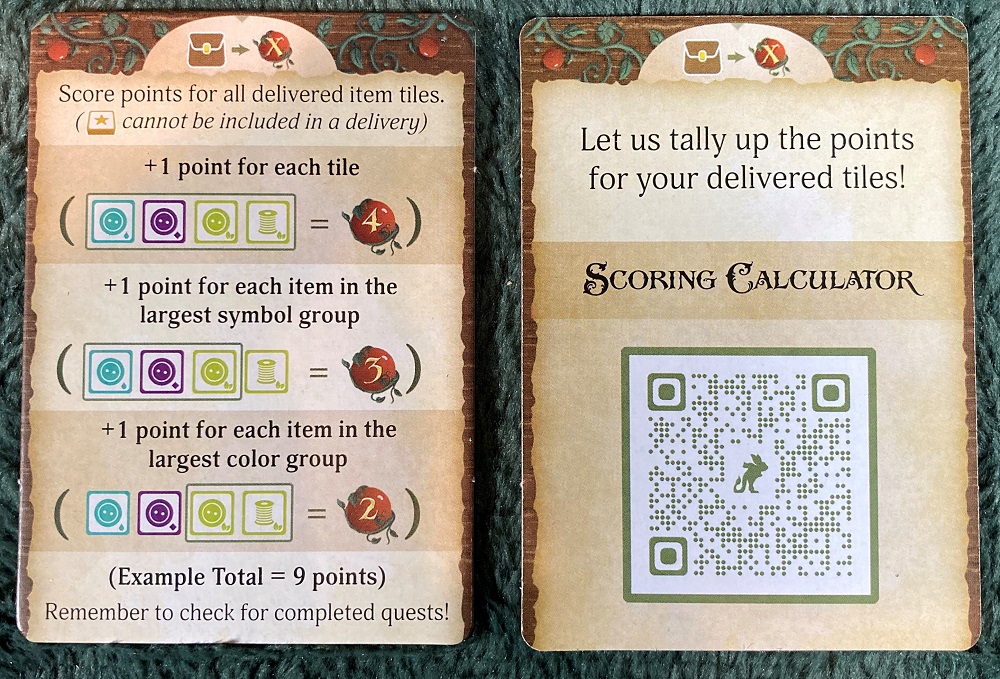
The game includes two identical reference cards to help with scoring. The back side has a QR code to the app which will do the scoring for you. This is useful, especially when learning the game or you are delivering lots of tiles such as at the end of the game.
How to Play Hickory Dickory
You can download a copy of the rulebook here.
The Goal
The goal of the game is to score the most points by the end of the game.
Setup
Start off by laying the clock board in the center of the table and placing the two side boards into the sides of the clock. Slot the clock hands into the center of the clock and set the minute hand at the 12 and the hour hand at the 7. Place the numbered action space tokens face up on their matching spaces on the clock, then separate the remaining action space tokens into sun and moon groups. Shuffle them and randomly place them in their matching spaces on the clock.
Gather the 10 wild item tiles and place them on Itsy’s Web and then put all the remaining tiles into the bag. Shake the bag to mix the tiles and then draw 4 to place in the Discount Bin spaces on Itsy’s Web. Now draw 11 more random tiles and place on the 11 leaf outer ring spaces around the clock. Search the favor deck for the four cards with the acorn icon on them and shuffle them before dealing them to the players. Return any unused cards to the deck and shuffle it. Place the favor deck face down on its spot near Itsy’s web. Shuffle the quest deck and place it in its spot to the left of the clock and reveal the top two cards.
Set the cat paws, die, and 50 point markers off to the side. If playing with 2 or 3 players, place the corresponding blocker on the minute hand. Players each choose a color and collect the corresponding mouse meeples, mouse cards, and score marker. Place the priority marker on the priority track on the color of the most punctual player and randomly distribute a hunt board to each player. Players then place their Scaler mouse meeple on the starting pinecone on the left chain track and then place their Scurrier, Scavenger, and Spotter on the inner ring spaces of the clock at the numbers shown on their hunt board. The Scamp starts the game out of play, so place this meeple on the Scamp cards. After each player places their score marker on the starting space of the score track, you are ready to play.
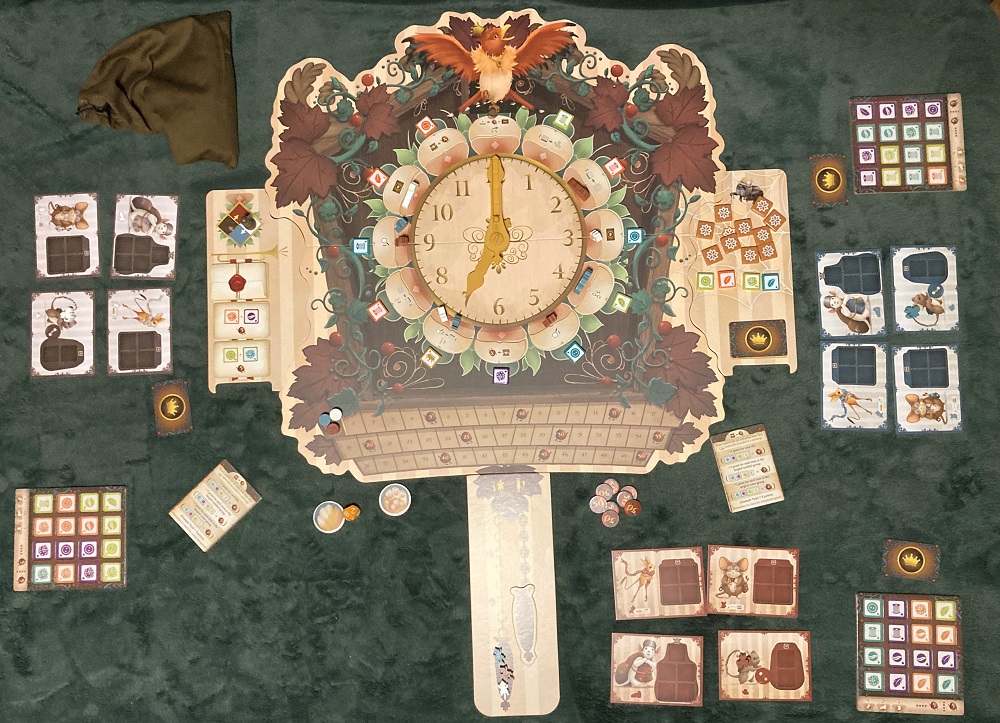
Gameplay
Hickory Dickory is played over the course of five rounds, each made up of 12 turns called Ticks of the Clock. There are three things that occur during a Tick. First the minute hand is moved to the next number on the clock. Next the mice on the minute hand activate individually starting with the mouse at the front of the minute hand. Finally, the mice on the inner ring space activate in order according to the priority track. Mice on an outer ring space do not activate. If there are no mice at a number, either on the minute hand or at that inner number space, move on to the next Tick.
When a mouse on the minute hand activates, it can either stay on the minute hand or jump off to the outer ring space and perform the current action. Mice on the inner ring space can move to the outer ring space and perform an action or jump onto the minute hand. If there is no space on the minute hand, move all the mice on the hand forward to make space, bumping off the mouse at the front. Bumped mice activate immediately and can either jump to the outer space of the current number or jump to the previous outer ring space where they can perform the current action.
A mouse that goes to the outer ring space can collect a tile, if one is still there, and then perform the action. The tile is then placed in an empty storage space on that mouse’s card. If a player has more than one mouse at a number, whether on the minute hand or one of the spaces, they can trade tiles among their mice at any time for free. Each space has a token with one or more actions on it. Some require you to spend a tile of one of your mice at that space. Actions include moving your Scaler mouse up the chain, claiming a tile from the bag, drawing a favor card, or visiting the market. At the 6 and 11 spaces, you can deliver your mouse’s items. At the 12 space, you can return relics to Lord Cuckoo to score 5 points as well as draw a favor card, and then leap to the 1, 2, or 3 outer ring space.
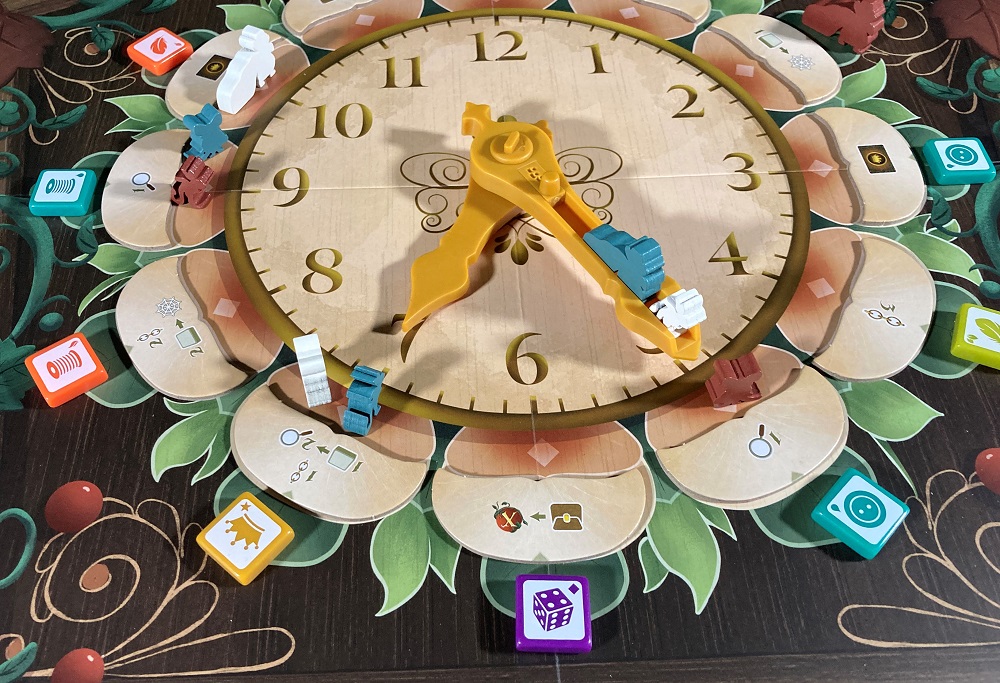
At the market, a mouse can claim two tiles from the discount bin or one wild tile that counts as every color and every symbol. Players earn points when they deliver items at the 6 and 11 spaces. They score 1 point for each item, 1 point for each item in the largest symbol group and 1 point for each item in the largest color group. Also, if they have the same item as listed on one of the current quest cards, they score the additional points listed and then discard the quest card. The items shown on favor cards can also be used to score points during delivery and then the favor card is discarded. Finally, place items onto matching empty spaces on your hunt board. Wild tiles can go anywhere. However, once a tile has been placed, it cannot be moved. Any tiles that cannot be placed on the hunt board are returned to the bag.
Points are also earned by the Scaler mice on the chain. Various actions allow you to move your Scaler mouse along the chain. As it lands on or passes point spaces on the chain, score those points. When it reaches the leaf at the top of the chain, score the points listed just above the pinecone weight token on the right chain and then move the weight token up to cover that point value. Return your Scaler to the starting pinecone on the bottom of the left chain.
When the minute hand reaches the 12 and the Tick has been resolved, before advancing to the 1 space, Lord Cuckoo lets out a royal CHIRP to remind players how to refresh the board. C stands for Cat Paws. Roll the cat die and twice and place a cat paw over the action space at each number rolled. If the same number is rolled twice, place both cat paws at that space. Any mice on a space with a cat paw are moved clockwise to the next space without a cat paw. They do not claim tiles or perform actions. H is to move the hour hand one number forward. If it moves to the 12, the game ends immediately. I is for moving all mice on the outer ring to the inner ring of their current space. R is to refill the the quest cards and the tiles on the outer rings as well as in the empty spaces in the discount bin at the market. Finally, P is for moving the priority marker one space clockwise.
Game End
The game ends when the clock strikes midnight (when the hour hand moves to the 12 space). Players can now score some additional points. One way is to look at the hunt board. Score 5 points for each row and column filled on hunt board. Next take all of the item tiles on all of your mouse cards and put them into one pool. Score them as if you were delivering them. You may use favor cards for scoring, but do not put these tiles on your hunt board. After everyone has finished scoring, the player with the most points is the winner. In case of a tie, the player with the most spaces filled on their hunt board is the winner and if there is still a tie those players share the victory.
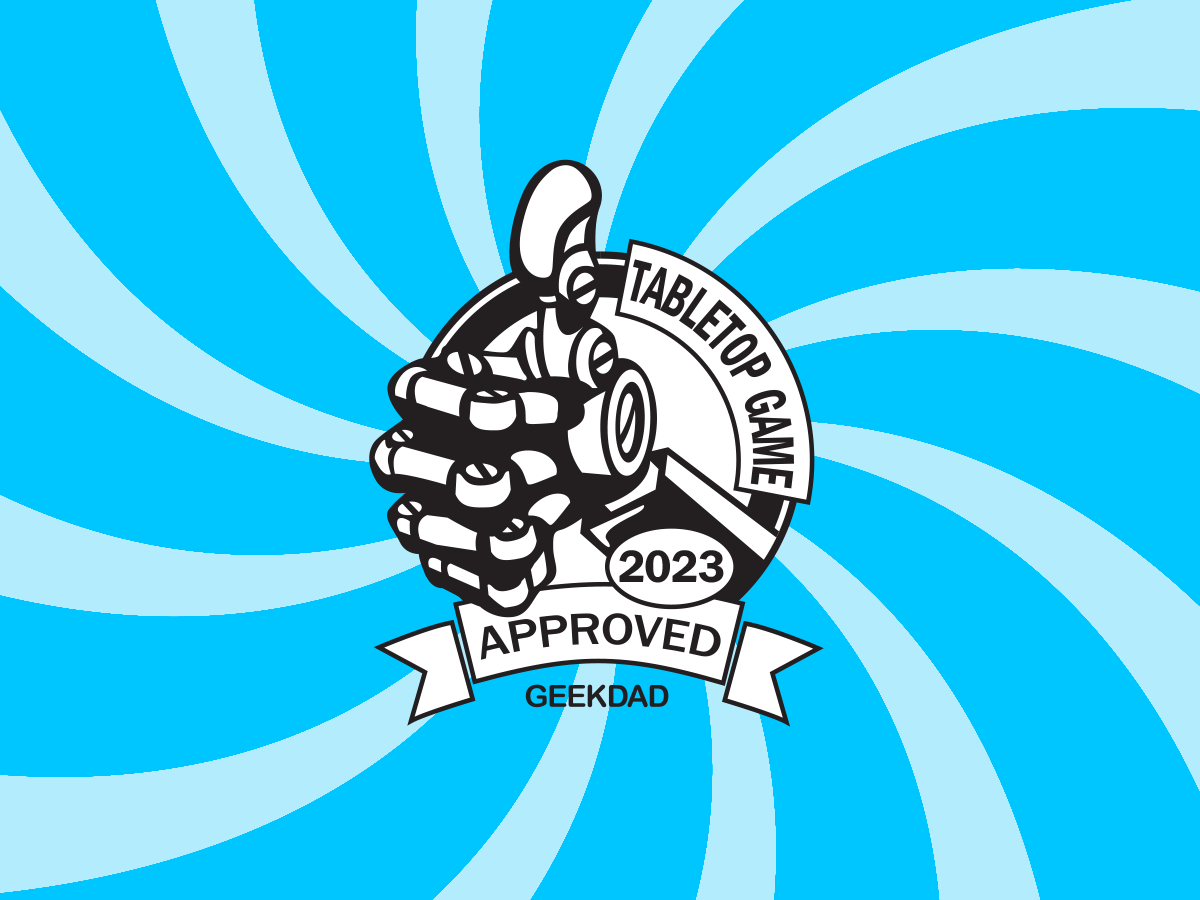
Hickory Dickory is GeekDad Approved!
Why You Should Play Hickory Dickory
Hickory Dickory is a variation of the usual worker placement game. In fact, it is called a worker rotation game. Instead of players placing their mice anywhere they want, they must use the minute hand of the clock to move around the various spaces. Once a mouse has been activated and is on an outer ring space, it is done for the rest of the round and not available until the next round after the CHIRP. Hickory Dickory is a game that is easy to learn and to teach since the concepts are fairly straightforward. Even the icons for the actions are easy to remember after playing for a bit. While the game may seem simple, there is also a lot of strategy involved.
As with all of the games I have played by Plaid Hat Games, the components are of good quality and the artwork is great and helps carry the theme. The art on the gameboard looks just like a traditional cuckoo clock and the clock hand assembly actually fits right into an opening in the middle of the gameboard so it does not slide around during play. While the items could have been represented with cardboard counters or tokens, the colorful plastic tiles really take this game to the next level. Not only do they look and feel great, they also are easier to mix around in the cloth bag.
While the game looks great, the gameplay is equally impressive. I really like that each of a player’s mice workers have their own unique abilities. Scurrier mice are great for jumping ahead to grab items before other players can get them. Since Scavengers have a larger bag, they are good for delivering items. Due to the larger size of their meeple, they are good for bumping other mice off of the minute hand, but also can be bumped off more easily as well. Use the Spotter mouse for searching for tiles since they let you draw an extra tile and pick the one you want to keep. This is great when going for those quest cards. The Scamp doesn’t come into play until the second round in most cases. While it does not have a lot of space to carry items, the action on the 1 space lets you teleport it to a new space and perform an action, even if it was in the outer ring and had already been activated for that round!
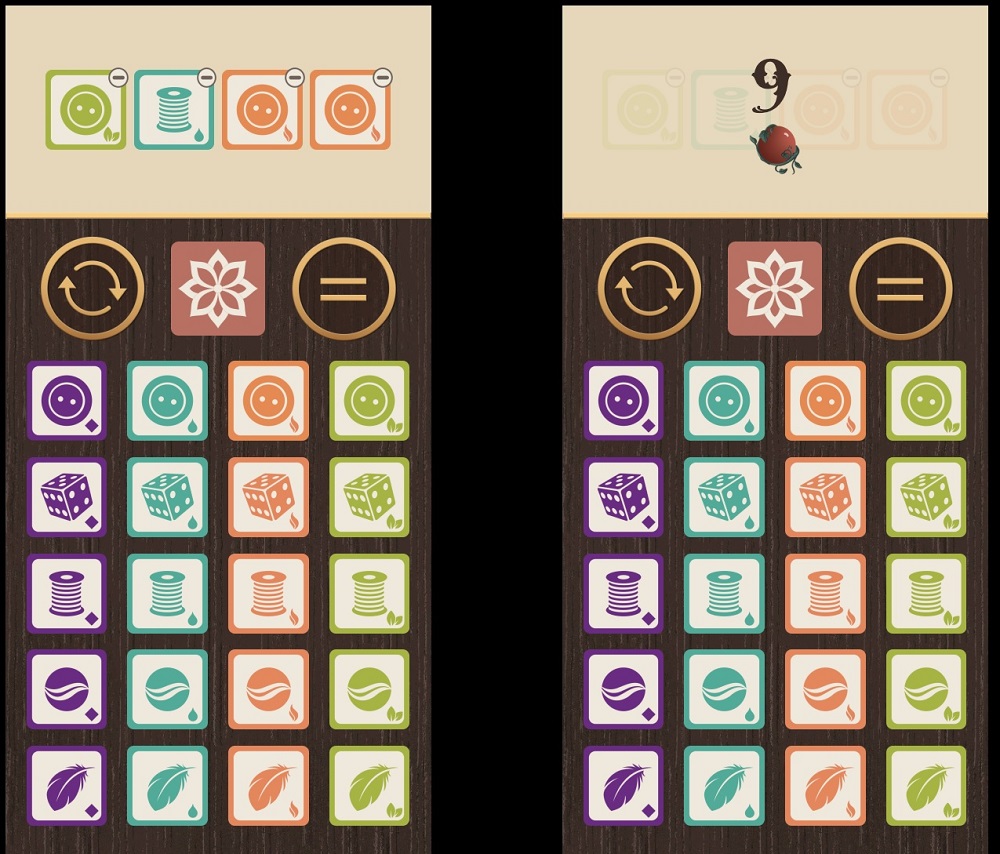
I really like the strategy involved in Hickory Dickory. While you only have three mice to control at the start, there are a lot of things to consider. During the first hour, your mice are scattered around the clock based on your hunt board. Therefore, there may be several Ticks where you do nothing. While you are looking for items to collect, you also want to consider the actions at each space. Early on, the Scalers are important since you want to get those higher points for being the first up the chain. However, getting favor cards can give you additional actions or help you complete quests. Since there are only two quest cards out per round, you want to try to score one of them before the other players. This is more challenging when there are more players. Even going to the market requires some thought. Do you take two items from the discount bin or take a wild item? More tiles are good, but wilds can help you complete quests and fill up rows on your hunt board. Plus they are always worth 3 points when delivering since you can ensure the item symbol and color match the highest group of each.
Hickory Dickory is a game that you will appreciate and enjoy more as you continue to play it. The first game or two is fun. However, once you get a feel for how the system and mechanics work, then you really start to add strategy and begin thinking several Ticks ahead. Not only are you thinking of what your mice can do, but how you can affect the mice of other players. You may want to jump onto the minute hand with one of your mice just to bump an opposing mouse off and prevent it from delivering this round since it forces that mouse to either jump to the outer right of the current space or the previous space. The blockers you place on the minute hand for 2 or 3 player games continues to make bumping an issue with fewer players since there is less space for mice on the hand. The rules also feature a variant for solo play where you must score 100 points within 6 rounds. Both blockers are placed on the minute hand and the game starts with the cat paws on the clock. Plus the cat paws can ‘scratch’ your mice, causing them to lose an item.
While I enjoy a worker placement mechanic in a game, that alone is usually not enough to satisfy me. Instead, I like to see it combined with other game mechanics. I am very impressed with Hickory Dickory’s modification to a worker rotation system. All actions are always available and can be used multiple times during a round. However, the items that are collected are the limiting factor as well as the opportunities to access actions and items that have passed as the minute hand progresses around the clock. If you like worker placement games, then you will most likely like Hickory Dickory. Even if worker placement is not your favorite, but you enjoy a fast paced game with strategy, a fun theme and beautiful art, then really consider this game. Personally, I really enjoy playing this game. The more I have played, the more I appreciate it and highly recommend it as a great addition to anyone’s game collection whether you play as a family or with a game group. For these many reasons, Hickory Dickory has earned the GeekDad Approved award!
For more information, visit the Hickory Dickory webpage!
Here is a quick trailer for the game.
Click here to see all our tabletop game reviews.
![]() To subscribe to GeekDad’s tabletop gaming coverage, please copy this link and add it to your RSS reader.
To subscribe to GeekDad’s tabletop gaming coverage, please copy this link and add it to your RSS reader.
Disclosure: GeekDad received a copy of this game for review purposes.
